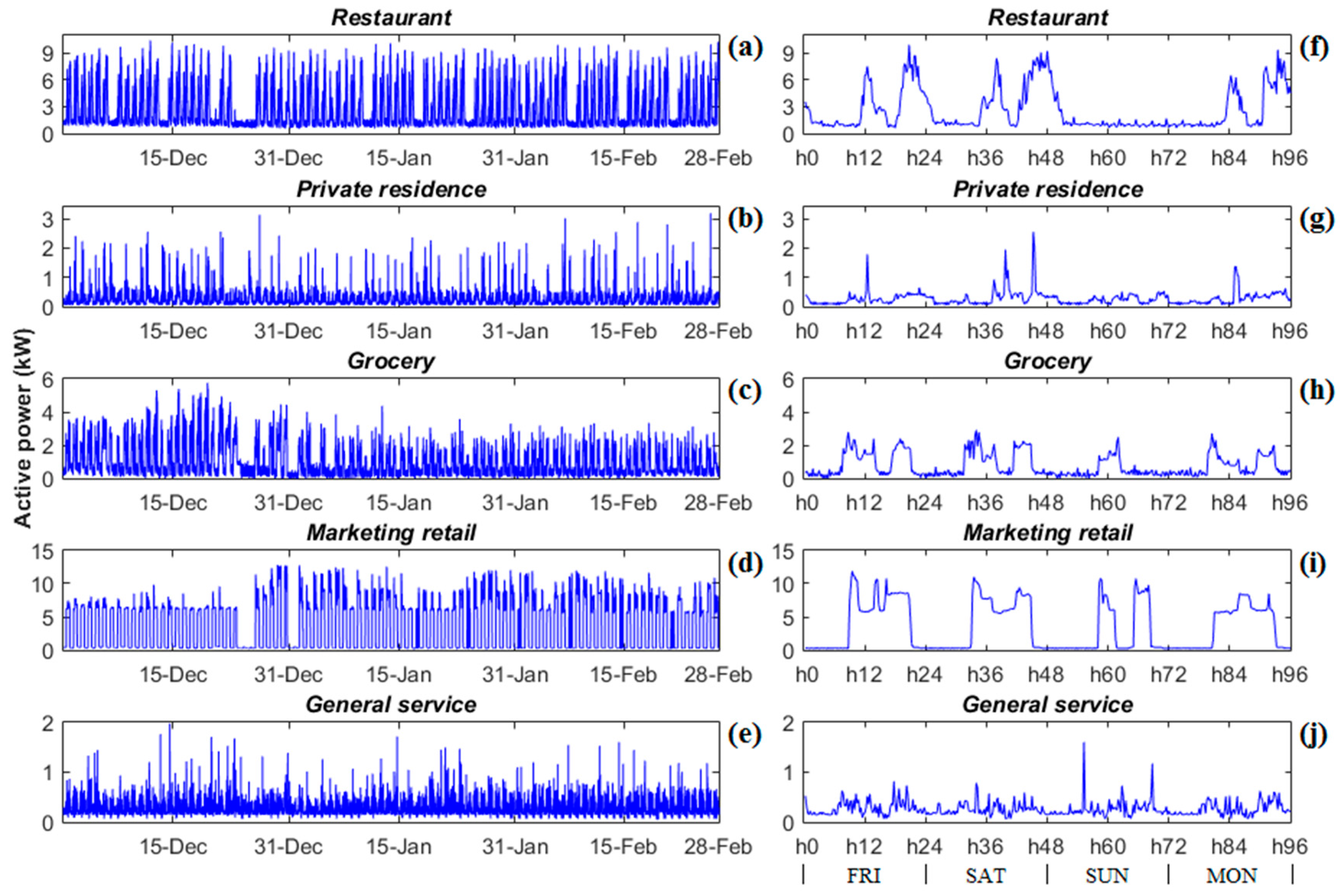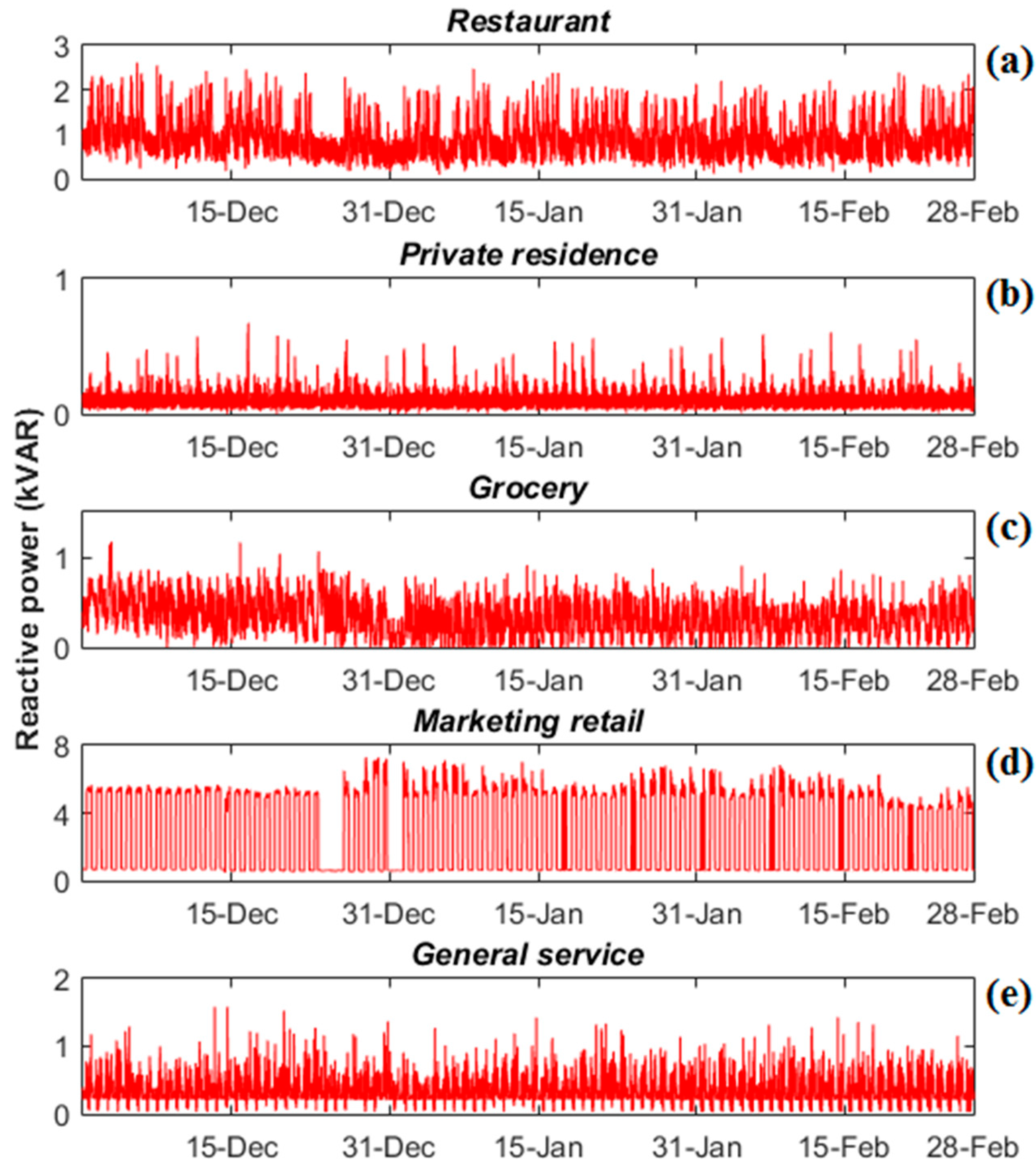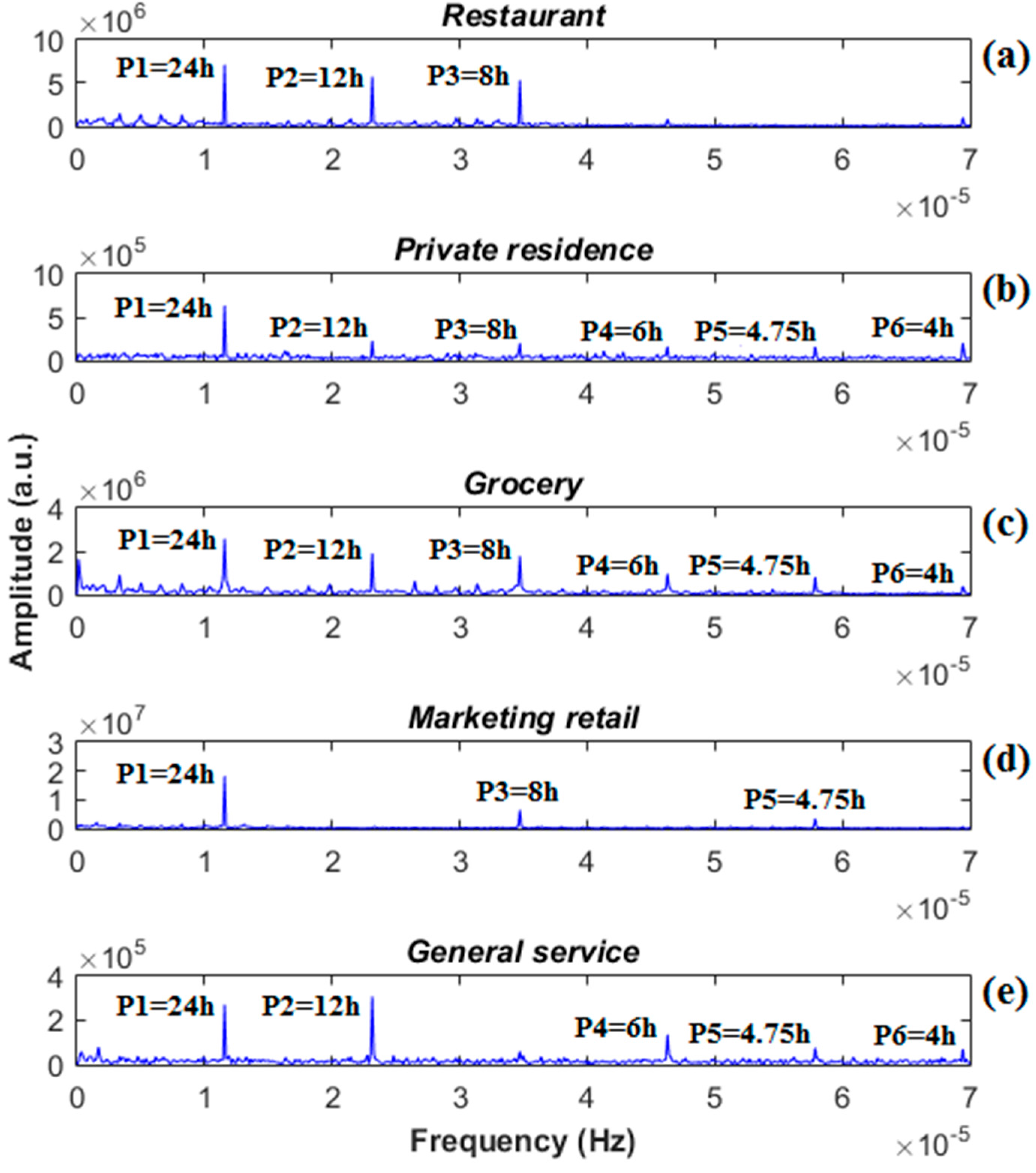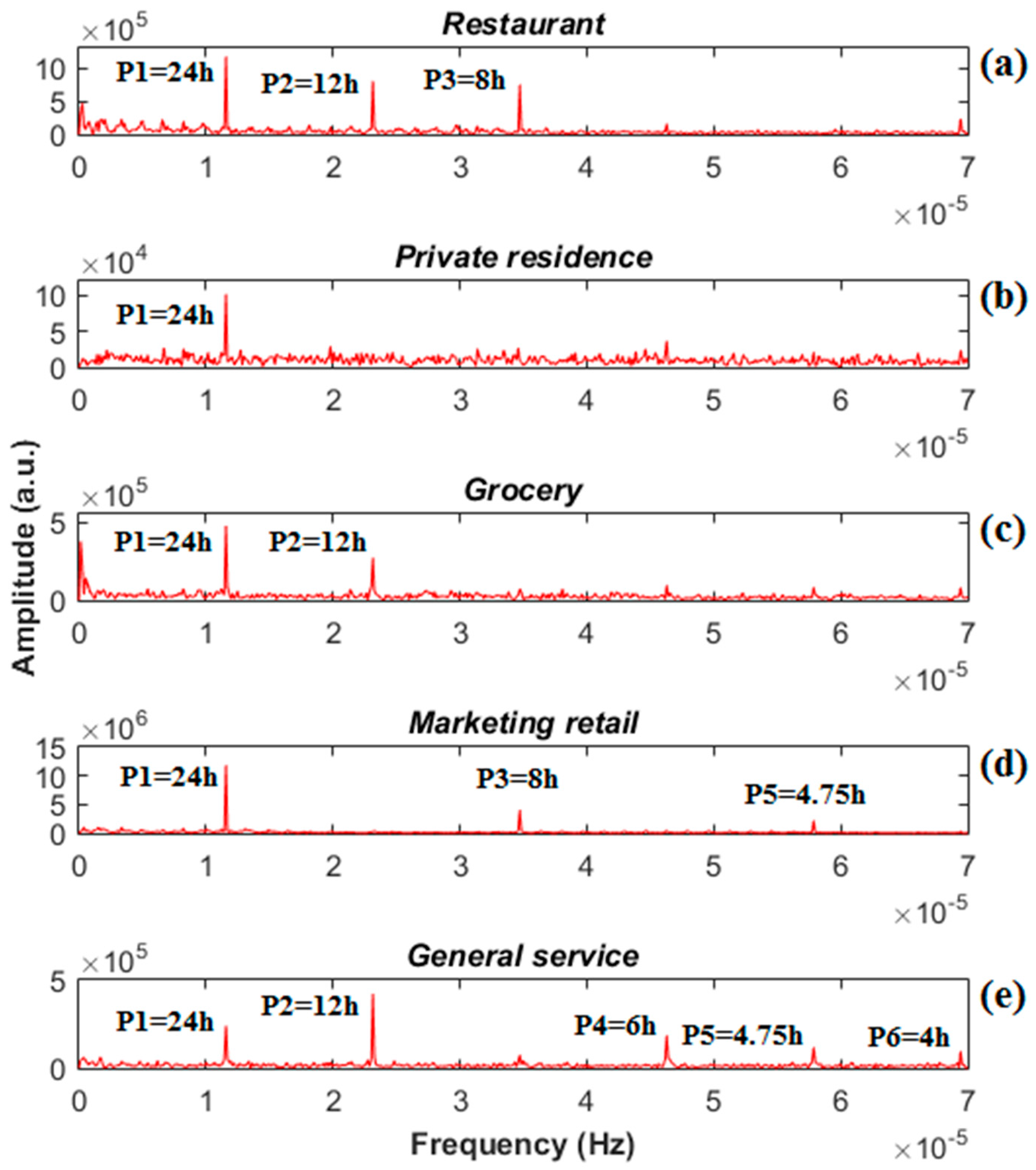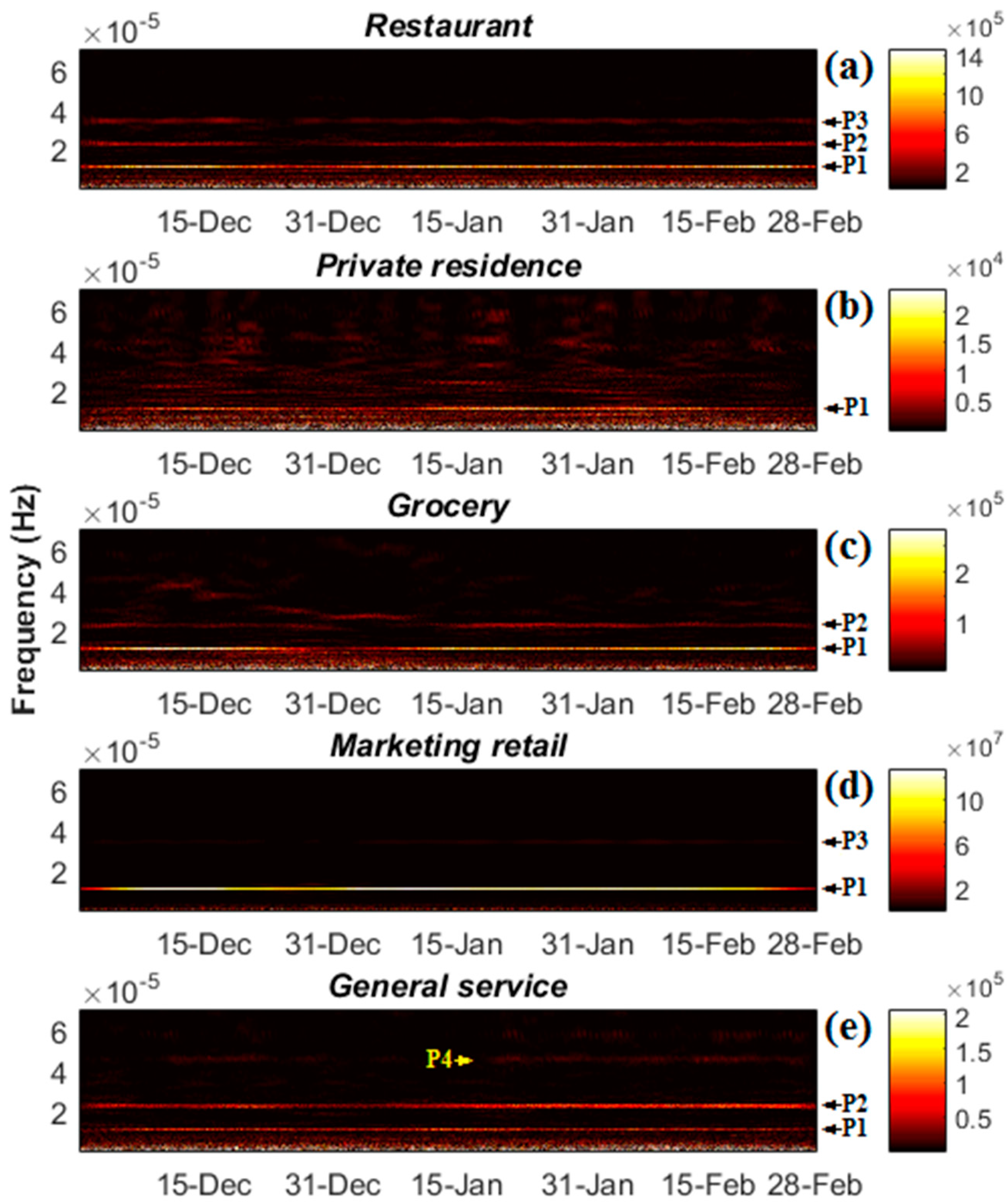1. Introduction
In the era of smart grids, the monitoring of power systems is needed for several purposes. It is used to detect failures in the electrical network, to underline the contributions of the distributed generators on the dynamic behavior of the whole system, and, more generally, to optimize the power distribution [
1,
2]. Nevertheless, the monitoring is not trivial, due to the massive use of non-linear loads and electronic-based equipment in residential, commercial, and industrial plants. In order to control the operation of the electrical lines, it is very important to implement and develop both on-line and off-line systems which are able to check the power fluctuations, related to the power absorbed by the numerous loads of each user. It is important to note that a disadvantage of this system is the large amount of data which has to be managed during the monitoring process. Even though several researchers have focused their attention on compacting the electrical information [
3,
4,
5], a more detailed investigation on this state of the art process highlights that the compression of the signal waveform is not as mature as for speech, image, and video compression [
6]. The complexity depends on the characteristics of the electrical signals of the modern equipment, which are related to the different loads (static, rotating, power electronics-based, and so on) and generators (deterministic-based, stochastic-based). The consequence of the diversity of the electrical loads induces the same electrical signals, which are nonlinear, non-stationary, and non-periodic.
In order to deal with this large amount of data and to manage the electrical signals, two main categories of mathematical tools, based on compression techniques, have been used: lossless techniques [
7,
8,
9] and lossy algorithms [
3,
10,
11,
12]. Reference [
6] reports a comparison of these tools (see Table I of [
6]), based on the compression ratio and the distortion values. However, the appropriate choice of the technique to treat an electrical signal, is not trivial. In fact, as an example, if the electrical signal is linear and stationary, traditional mathematical tools, like the standard Fast Fourier transform (FFT), can be the correct analysis method. Vice versa, in the presence of electrical signals that deviate from linear and periodic behavior, different and more complex tools are necessary, in order to correctly characterize the electrical power behaviors. In recent years, the Wavelet Transform (WT) has been used increasingly often for several different issues related to power systems at every level. In [
13], the authors study the modal parameters of power systems in order to analyze the origin of the small signal oscillations, thanks to the continuous WT that is able to detect the damping and frequency of the critical modes. Moreover, this approach uses the FFT to calculate the convolution integral of the continuous WT, in order to reduce the computational burden. The WT is also employed for the fault location and the power quality analysis in electric power systems [
14], where a combination of several mathematical tools is proposed, on the basis of behavioral indexes, neural networks, statistics, and WT. In addition to the WT, the Hilbert-Huang Transform (HHT) is an effective tool for studying the non-stationary phenomena of power systems. In [
15], the authors propose an iterative HHT to study the power quality waveforms in the presence of a sudden transition. Moreover, to discriminate the correct instant, they also use the Symbolic Aggregate ApproXimation. HHT, together with the discrete WT, is also used to analyze the power system areas with
coherent generator groups, therefore in no-fault conditions [
16].
In this framework, the WT [
12,
13,
14,
15,
16,
17] and the Empirical Mode Decomposition (EMD) deriving from the calculation of the HHT [
18,
19] were also used with success, in order to determine the properties of non-linear, non-stationary, and non-periodic electrical signals of passive or active distribution lines (i.e., in the absence or presence of renewable energy sources, respectively). These tools, together with the FFT, allow a complete analysis of those signals, both in time and frequency domain.
The WT, specifically, evidences the non-stationarity of the signals [
17,
20]. In the distribution lines, WT was used to analyze the absorbed power in anomalous conditions [
12], and to characterize different typologies of electrical users [
21].
In addition, the HHT-EMD produces a description of the behavior of different kinds of signals that are typically nonlinear [
22,
23,
24,
25], overcoming the limitations of the FFT analysis, which is able to quantitatively describe signals with linear, stationary, and periodic characteristics. The efficiency of the HHT analysis of electrical power signals has already been tested, by comparing the HHT-based results and the FFT-based results, both for seasonal periods [
26] and for long periods [
19]. For the sake of completeness, when both the non-linearity and the non-stationarity are present, the Duffing equation [
27] is an effective tool for investigating the electrical behavior of distribution lines.
This paper, in contrast to the previous literature and [
21], which describes the FFT and WT analysis of the active power, presents a complete and deep methodology, based on the FFT, WT, and HHT-EMD analysis of both active and reactive power. The dataset derives from measured data of distribution lines, feeding different typologies of users (private residences, groceries, marketing retails, general services, restaurants). We also want to emphasize that, whereas in our previous work [
19] we used FFT, WT, and HHT-EMD tools to study the different electrical behaviors of the active and passive distribution lines, here we use the same tools to highlight the different electrical behavior of end-users belonging to different typologies, with the aim of characterizing the end-user.
The paper is organized as follows.
Section 2 describes the theoretical background, illustrating both the WT and the HHT; data under investigation are presented in
Section 3;
Section 4 discusses the numerical results after having processed our dataset by means of FFT, WT, and HHT; lastly,
Section 5 is devoted to the conclusions.
3. Description of the Data and Coherence Degree
The dataset under investigation is constituted by the active and reactive powers absorbed by 25 different users, grouped into five different typologies (restaurants, groceries, marketing retails, general services, private residences). The sampling time of the measurements was fixed at 15 min, and the overall period of recording was three months, from the 1st of December, 2014, to the 28th of February, 2015, covering 90 consecutive days with 96 samples per day (90 × 96 = 8640 samples recorded per user). In exceptional cases (less than 0.5%), the power measurements were not available in the dataset, thus we connected the external values via interpolation. In this regard, after comparing different kinds of interpolation, the average of the values observed in similar circumstances (same hours in different days) turned out to be the most reliable method.
The first step concerned the time-domain analysis of the measured data, in order to extract the main features of the active power absorbed by the users, such as the maximum power and the typical timing of the power request. This analysis allowed an evaluation of the similarity level of the five users belonging to the same user typology and, then, whether it could be possible to average their behaviors, in order to identify the sample user of that typology, or to consider whether one user is representative of each typology. Successively, in order to estimate the likeness between users of the same category, we calculated the spectral coherence between the power signals of each couple of users, for the same typology. The time-frequency coherence of two signals,
x(
t) and
y(
t), is a real-valued function, defined as:
where
is the cross-spectral density between
x(
t) and
y(
t), and
and
are the autospectral densities of
x(
t) and
y(
t), respectively. The values of the coherence always range from zero to one [
32,
33].
Table 1 shows the coherence values obtained by the Equation (7), including the average coherence of each user. The less coherent users for each typology are: restaurant #4, grocery #1, marketing retail #2, general services #1, and private residence #5.
Finally, our proposed time-frequency analysis was completed. We will first plot the time-domain power signals of a user for each typology, over the whole data acquisition period. Next, we report on the frequency-domain analysis, including the frequency spectrum obtained by means of FFT, the WT scalogram, and the HHT analysis.
4. Results and Discussion
4.1. Temporal Analysis of the Active and Reactive Power
From the coherence analysis results, we have chosen one user which is the most representative of each typology.
Figure 1a reports the active power absorbed by the user
restaurant #2 in the trimester, whereas
Figure 1f is a zoomed-in view of a 4-day interval, from a Friday to a Monday of February. As it can be seen, this specific user mainly absorbs power during two specific periods, lunch and dinner time, respectively. Moreover, it is almost always closed on Sundays. The diagram points out when the absorbed power is very low, corresponding to the closing days. The Christmas holidays are evidenced by the longest closing period.
User #1 is the reference for the category
Private residence #1, and
Figure 1b diagrams its active power (supply contract of 3 kW). A detailed forecasting of the absorbed power is impossible to obtain during the day, nevertheless, it is mainly concentrated during the day hours. As you can see, there is no appreciable difference in the absorbed power, with respect to the Christmas period, as occurred in the previous case.
Figure 1c reports the power absorbed by the user
grocery #3, which has a 6 kW supply contract. The absorbed power is concentrated in two periods, the morning and the afternoon opening times. Sunday is the closing day. In addition, the time evolution of the power highlights, once again, a very low power request during the Christmas holidays.
Figure 1d shows the power absorbed by user #1 of the category
marketing retail, with a 10 kW supply contract. The absorbed power is regular during the whole daytime, specifically from 9 a.m. to 9 p.m. It is evident that the retail establishment is usually open on Sundays, until the lunch break. Finally, the retail is closed during Christmas day and New Year’s day.
Figure 1e regards
general service #2 (supply contract of 1.5 kW). The absorbed power is largely variable during the day, and it depends on the particular typology of the electrical load, including elevators, lights in common spaces, and so on, and therefore, the requested power is not predictable during the day.
Figure 2 shows a similar study of the reactive power, for the same users analyzed above.
As expected, in the private residences, the reactive power contribution is very low, because there are loads absorbing a very low quantity of reactive power. Vice versa, restaurants and marketing retail establishments produce the most interesting users for the analysis of the reactive power, because their typical electrical loads are transformers and motors. In both cases, you can observe a power request during the day hours, whereas small values of reactive power are cyclically requested by the restaurant during the night.
4.2. FFT Analysis
The Fourier spectrum of the first considered user (
restaurant #2) shows the most important frequency components, which are at
f1 = 1.157 × 10
−5 Hz,
f2 = 2.315 × 10
−5 Hz, and
f3 = 3.472 × 10
−5 Hz, corresponding to 24, 12, and 8 h, respectively, and are named P
1, P
2, and P
3, respectively, in
Figure 3a. The Fourier spectrum of
private residence #2 (see
Figure 3b) highlights the contributions of
P1,
P2,
P3,
P4 (
f4 = 4.630 × 10
−5 Hz, corresponding to 6 h),
P5 (
f5 = 5.787 × 10
−5 Hz, corresponding to 4.75 h), and
P6 (
f6 = 6.944 × 10
−5 Hz, corresponding to 4 h).
Figure 3c represents the Fourier spectrum of
grocery #3, where the same peaks of the previous case are detected, without the peak
P6. In the case of
marketing retail #1, the Fourier spectrum only contains the frequency components,
P1,
P3, and
P5 (see
Figure 3d), related to the odd components of the Fourier spectrum. Frequency contributions of the
general service #2 (
Figure 3e) include
P1,
P2,
P4,
P5, and
P6.
When observing the Fourier analysis of the reactive power (see
Figure 4), it becomes evident that the main frequency modes are the same for the related user of the active power spectrum, when the absorbed active and reactive powers are comparable. In our case, the only user which has a reactive power that is much lower than the active one, is the private residence (see
Figure 1b and
Figure 2b). In fact, the spectrum of the active and reactive power contains different frequency peaks, all of the harmonics of the spectrum for the active power, and only the first harmonic for the reactive power.
4.3. Wavelet Analysis
The WT analysis is an effective mathematical method for studying the non-stationary behavior of the electrical signals.
Figure 5 shows the WT scalogram of the active power for each user under study. In particular,
Figure 5a is related to the
restaurant, where
P1 and
P2 appear during the Christmas time, thus resulting in quasi-stationary modes.
P3 takes into account the closing days, highlighting an intermitting excitation mode.
Figure 5b reports the WT analysis for the
private residence, where it is observed that, apart from the stationary mode
P1, the other harmonics are less significant and discontinuous. Concerning the
grocery user,
Figure 5c shows that the relevant modes,
P1 and
P2, appear during the whole trimester, while the other modes are only present in December.
Figure 5d points out that, in the case of the
marketing retail,
P1 is the only stationary mode, and instead,
P3 and
P5 are low power and non-stationary modes. Finally,
Figure 5e illustrates that the first two peaks of the
general service are quasi-stationary modes, while
P4 is only present in the final acquisition period.
Figure 6 reports the WT analysis for the reactive power of the same users discussed above. In the case of the
restaurant, the scalogram shows the stationarity of the
P1 mode;
P2 is quasi-stationary, whereas
P3 is attenuated with respect to the corresponding active power peak. Concerning the
grocery, the
P1 mode is stationary; however, it is weak during the Christmas period, which is related to a different work organization of the user.
Marketing retail and
general service show frequency modes similar to those obtained in the active power analysis during the whole period. As expected, the WT scalogram of
private residence confirms that the reactive power is almost negligible.
4.4. HHT Analysis
In order to provide an extensive analysis of the tools available to treat these particular electrical signals, characterized by the non-linear and non-stationary behavior, this section presents the results carried out by applying the HHT transform to one of the previous users (restaurant). Similar results are found for the other users (for the sake of brevity, not shown here).
In agreement with the EMD analysis on the basis of the HHT technique, the active power signal is decomposed into 12 IMFs (
Figure 7, left column), whereas the reactive power one is decomposed into 11 IMFs (
Figure 7, right column), for the whole sampling period. The IMFs are organized into a decreasing frequency order, due to the higher number of temporal oscillations of the signal, with respect to each successive iteration. The evidence that the active power shows a larger number of IMFs than the reactive power, is due to its higher non-linear behavior of the electrical signal under investigation. The frequencies of the intermediate IMFs, in our case #4–6, are very close to the ones found by performing the FFT analysis; all of the other IMFs have frequencies that do not correspond to those of the FFT harmonics.
Figure 8a,b show the frequency peaks of the IMFs for active and reactive power, respectively. By comparing the HHT spectrum with the frequencies computed by the FFT, we observe that the HHT frequency range is much larger than the one found by using the FFT, and this means that the electrical signal of both the active and reactive power, is not periodical and non-linear. In fact, when comparing the excited modes found in the FFT (see
Figure 3a and
Figure 4a) and HHT spectrum, we observe that only the frequencies of the IMFs #4–6 for the active power and the reactive power, overlap with the frequency peaks computed by FFT analysis.
4.5. Discussion
From the results reported above, we find out that the FFT provides general information on the frequency behavior of both the active and reactive power. It is worth noting that the FFT is not the best method for studying non-stationary and non-linear signals acquired over a long period. In fact, the Fourier spectrum does not provide information on the time instant when the mode is excited, because it is time-independent. In the presence of non-stationary signals, the WT analysis overcomes this problem, because it computes the Fourier spectrum for different temporal windows. For example,
Figure 5 and
Figure 6 show that the frequency modes, for both the active and reactive power, are often not stationary during the whole period (three months), and the amplitude of the frequency peaks is not always constant.
FFT and WT are not able to extract all the frequency modes of the non-linear electrical signals, because they are covered by the noise and/or other frequency modes. From our analysis, the HHT transform has turned out to be a very useful tool for detecting all the frequency modes present in the active and reactive power of the case-studies. In fact, the information coming from the HHT is richer than that from the FFT, including a larger number of frequency components. Specifically, in the studied cases, for both active and reactive power, the modes of the FFT spectrum are contained in the central region of the HHT spectrum. The higher and lower frequency modes are not revealed when using the FFT and WT analyses, whereas the HHT spectrum includes the working modes at high and low frequency regimes, which are not revealed by the FFT analysis. The extraction of all the components is very important for several reasons. For example, many electrical loads contain magnetic parts, whose losses are frequency-dependent; therefore, it is only possible to correctly evaluate the losses if all the frequency components are known. Again, the magnetic parts of the electrical loads can be strongly nonlinear, and thus, the effects of the high frequency components cannot be negligible. Other similar examples of nonlinear and nonstationary signals can support the importance of the proposed analysis. Nonetheless, computational requirements for performing WT and HHT-EMD analysis are not significantly higher than the ones needed for a FFT calculation, and for this reason, the proposed methodology is effective and fast.
